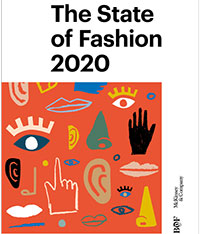FW
The coronavirus disease (COVID-19) is affecting every sphere of life including manufacturing activities, businesses, etc., across the globe and India is also not spared from the panic situation. The textile industry predominantly employs migrant workers from different States and also a large population comes for work from far off places using public transport. Under the current scenario, especially the constant preventing measures being taken and awareness created by the Government to fight against the Coronavirus pandemic, majority of the workers are not reporting for work and the migrant workers are also returning to their native places.
This situation is likely to intensify and result in mass stoppage of production in the industry. With the expected steep reduction in demand due to sudden stoppage of exports / imports and also domestic sales due to the closure of malls and retail showrooms, the industry is likely to face unprecedented and severe losses and needs immediate financial relief to mitigate the crisis. Therefore, the textile industry, being labor and capital intensive, needs immediate help to tide over the worst ever crisis being faced by the industry.
Ashwin Chandran, Chairman, The Southern India Mills’ Association (SIMA) informed that the association has sent a representation to the Prime Minister appealing him to mandate the banks to provide a moratorium of one year (April 01, 2020 to March 31, 2021) for repayment of principal and interest amount to the banks to enable the Indian textiles and clothing industry to tide over the crisis. He stated that the country has never witnessed such a crisis situation before and therefore, the textiles and clothing industry requires a helping hand from the Government through this measure. Such a relief, if extended, will go a long way to help the industry to tide over the crisis and ensure the survival.
 Singapore-based INA Systems offers customised conveyor systems for garments and home textile manufacturers. The company specialises in intelligent material handling systems, box storage, MES and intelligent transport, as well as sorting systems which help manufacturers improve their production processes. It recently participated in the GTE 2020 exhibition held in New Delhi. Manpreet Singh, Manager-India of the company elaborates on its operations and the current market in India.
Singapore-based INA Systems offers customised conveyor systems for garments and home textile manufacturers. The company specialises in intelligent material handling systems, box storage, MES and intelligent transport, as well as sorting systems which help manufacturers improve their production processes. It recently participated in the GTE 2020 exhibition held in New Delhi. Manpreet Singh, Manager-India of the company elaborates on its operations and the current market in India.
The future of Indian garment and textile machinery market is very bright as increasing labor cost is fuelling demand for such machines in the country. “The conventional modes of production take a lot of time for handling and transportation of goods. Automation can help manufacturers reduce this time and increase their WAP and outputs by 20 percent to 25 percent. However, the awareness on automation is currently quite low in India,” avers Singh.
The Indian customer needs to be made aware of the benefits of automation. “The domestic Indian market offers great opportunities for manufacturers like us,” notes Singh. “We have been getting multiple orders as customers from across India as well as from foreign countries have started adopting our systems in the last two years,” he adds. “Some of our customers also run showroom chains in India.”
Though Bangladesh has an edge over India as it does have a duty structure, the Indian garment and textile sector offers a huge potential. “Domestic players in the both eastern and western parts of country are registering a good growth,” adds Singh.
"With many markets witnessing slower growth and low consumer confidence, the fashion industry is going through a seismic transformation. As the recently released ‘The State of Fashion 2020’ report by The Business of Fashion reveals, under pressure brands are embracing digital operations, boosting earnings while tackling sustainability issues."
 With many markets witnessing slower growth and low consumer confidence, the fashion industry is going through a seismic transformation. As the recently released ‘The State of Fashion 2020’ report by The Business of Fashion reveals, under pressure brands are embracing digital operations, boosting earnings while tackling sustainability issues.
With many markets witnessing slower growth and low consumer confidence, the fashion industry is going through a seismic transformation. As the recently released ‘The State of Fashion 2020’ report by The Business of Fashion reveals, under pressure brands are embracing digital operations, boosting earnings while tackling sustainability issues.
The report identifies the top 10 fashion industry themes for year 2020. New channels, markets and research are creating opportunities for companies that find the right formula, says the report. A new breed of super winners is emerging who are attracting the best talents in the industry.
However, the outlook for 2020 appears to be subdued as according to 55 percent respondents conditions will worsen in the year. Fashion companies may become more resilient in 2020 and assign additional resources to understanding risks and putting forward solutions. Also, Chinese brands may direct some of their attention towards other growth markets like India, South Asia, Russia and Middle East.
Focus on social media trends and content creation
As social media platforms will focus on high-quality or user-generated content, storytelling will become more important in the months ahead. These platforms will be used to tap into the “drop culture” associated with streetwear labels. By 2023, these platforms could account for a fifth of all online sales in China, a staggering $166 billion amid a pervasive culture of innovation. Brands will spend time evaluating these emerging social media trends and focus on content creation that strikes a chord across channels.
important in the months ahead. These platforms will be used to tap into the “drop culture” associated with streetwear labels. By 2023, these platforms could account for a fifth of all online sales in China, a staggering $166 billion amid a pervasive culture of innovation. Brands will spend time evaluating these emerging social media trends and focus on content creation that strikes a chord across channels.
Fashion retailers will set up stores focusing on service, convenience, personalization, and customer experience. Smaller in size than existing outlets, each of these stores will have their own look and feel depending on location. They will use cutting-edge design, highly focused assortments, and experiential elements to strike a chord with local communities. Some may be pop-ups, while others will be found in new corners of established neighborhoods.
Acceleration of sustainability initiatives
This year will also see the fashion industry grow its sustainability engagement as brands will develop new fabrics, cut destruction of unsold goods and ensure products can be repaired or recycled. Some brands have committed to radical transparency in the supply chain, and have seen positive results, while several e-commerce platforms have enabled searches for sustainable brands.
Some of fashion’s biggest names will join the ‘materials revolution,’ in 2020 as they will opt for synthetic and reengineered fibers, including biofabricated leather and e-textiles. This will not only enhance their design palette but also offer them greater functionality, and range of commercial opportunities.
Rise in inclusive culture
Chief diversity and inclusion officers will rule as customers and stakeholders will keep a close eye on developments. Brands will launch ranges catering to underserved demographics, from brands for people with disabilities, such as IZ Adaptive, to Good American, which offers jeans in a wide range of tailored sizes, and trans-friendly lingerie brand Carmen Liu Lingerie.
Larger share for Asian manufacturers
Asian manufacturers will get a larger share of global mass market, as they will continue to move up the value chain and leverage in-house design capabilities and e-commerce platforms such as Amazon. A significant driver of this growth will be the rising consumer demand for these brands. To stay ahead of the game, international brands need to strengthen their value propositions in the months ahead.
Digital companies to reevaluate operations
Brands are obsessed with making their digital operations a success by offering compelling customer experiences and streamlined operations. However, some of the world’s largest companies are divesting themselves of e-commerce businesses. These companies will need to reevaluate their business models in 2020 and seek levers to boost their revenues.
As a result of COVID-19, Tirupur has to pay five to 15 per cent more for synthetic dyes. Availability of dyes and pigments has decreased by 20 per cent. On an average, over 470 units in Tirupur require 500 tons of synthetic dyes every month. Now, its unavailability has forced traders to look for alternatives — natural dyes. However, it is not possible to procure them in such huge quantities, considering their limited sources. Besides, when a unit uses synthetic dyes on fabric, it is not practically feasible to make a switch to, or experiment with, natural dyes.
Although chemical industries in Gujarat and Maharashtra meet nearly 80 per cent of Tirupur’s demand for synthetic dyes and chemicals, it is China that supplies them with the raw materials. However, pigment production in these states has taken a hit as shipping from Chinese ports has slowed down in the past four weeks.
A hike in the price of pigments is sure to increase the fabric rate as well. There may be a 15 per cent to 20 per cent increase in cloth price though the difference in rates will reflect on garment orders, both domestic and export, only in the next financial year.
Textile Fairs India will be held in New Delhi, July 23 to 25, 2020, along with Fashion Connect and Yarnex. The show will bring together clothing and textile manufacturers, accessories businesses, wholesalers, buyers, and exporters to network and forecast trends for the upcoming season. Countries will take part in the event and showcase textiles such as yarns and fibers, trims and embellishments, and readymade garments. A special focus will be on sustainable fashion. Industry professionals will discuss how to make production more environmentally friendly and a dedicated sustainable fashion showcase will shine the spotlight on recycled and upcycled clothing. A number of design and product awards will also feature during the event. Yarnex brings together manufacturers and suppliers of fibers, yarns and related services to showcase their merchandise to buyers from across the world. F&A is a fashion and accessories show. Fashion Connect connects clothing brands and contract manufacturers with the entire retail fraternity. Besides being a platform for sourcing, the event also disseminates information on fashion trends.
Textile Fairs India launched in 2004 and is run by textile sourcing exhibition business SS Textile Media. The business has also hosted a number of trade shows in knitwear capital Tirupur and in Ludhiana.
Nigeria is taking steps to revive the textile industry. Forex for textile traders has been banned. A gas tariff for textiles has been approved but is yet to come into full operation. Problems plaguing the Nigerian textile industry include: lack of sufficient electricity supply, counterfeiting and smuggling, among others. A major problem is cost of energy. One suggestion is to set up a textile task force to combat smuggling of textiles and fix a minimum value for textiles coming into Nigeria.
Stagnated by unchecked smuggling and dilapidated infrastructure in the mid ’80s and early ’90s the Nigerian textile industry used to have about 95 companies. The sector was one of Nigeria’s largest and oldest manufacturing sectors and rated third in Africa behind Egypt and South Africa.
Nigeria aims at producing up to 4,50,000 metric tons of cotton in three years. This is part of an effort to revive the textile and garment industry. Up to 3,00,000 farmers will be engaged to achieve this aim in 26 out of the 36 states of the country. Six thousand metric tons of cotton seed have been imported and an additional 2000 metric tons have been sourced locally. The total expected yield at the end of the current season is 3,02,440 metric tons.
Rreadymade garment exports dropped around 4.51 per cent in February 2020. COVID-19 outbreak is expected to impact exports for the next few months and has impacted sentiment in the European market — the largest for Indian exporters. Recent trends in US apparel imports have also been discouraging. For orders placed, delivery is taking much more time than usual. This is the primary reason for the fall in exports. As most countries are under lockdown, stores are shut and people don’t go out and stay at home. The drop is mainly due to weak buying and many customers’ going bankrupt or witnessing lower sales.
Indian apparel exporters expect a correction of around 100 to 150 bps in their operating profitability in fiscal ’20. This is expected to result in a moderation in debt coverage metrics. The impact is likely to be more pronounced for leveraged and smaller companies, with limited bargaining power with customers, and modest liquidity cushion.
When the outbreak started in China, initially it was looking like an opportunity for Indian exporters. This was because European customers, who were traditionally sourcing from China, started discussions with Indian exporters for new orders. But ever since the virus started spreading to Europe, things have turned upside down.
Apparel Export Promotion Council (AEPC) has issued a trade and health advisory that shares its initiatives of identified alternate sources of input suppliers to help diversify sourcing of raw materials and identified products with potential for exports in US markets. As for apparel export, China has recently offloaded products worth $4.9 billion in top nine markets. In these markets, though India has captured only $ 314.4 million.
Germany, Korea, Russian Federation, France and Netherlands are among the top markets where India couldn’t capture the offloaded space by China. While in Australia, UK and US, India captured the Chinese offloaded space by 29.9, 10.7 and 9.7 per cent, respectively.
As for raw material sourcing, India’s import of yarn, fabric and interlining from China were 46, 67 and 99 per cent respectively. Indonesia and Japan can be an option for yarn, while Egypt and Korea should explore for fabric. Out of top 10 product segments exported to the US by China, India has a potential for seven categories, while there are four such products exports to EU that India can tap. Some common products for US and EU are jerseys, pullovers, cardigans, waistcoats, women’s trousers, bib and brace overalls and men’s trousers.
E-commerce company Global Fashion Group has set targets for 2022. All top 30 brands it sells will be engaged in sustainability. Water from its warehouses will be comprehensively tracked. At least 50 per cent of all GFG waste will be recycled. There will be 100 per cent carbon mapping and science-based reduction targets will be set for the entire group. In countries that use delivery packaging, 100 per cent of these will be made from sustainable materials. Working conditions risk assessments will be completed, and high-risk providers audited.
Global Fashion Group, founded in 2011, which owns websites including The Iconic, Zalora and Dafiti, employs 12,828 people across 19 countries with 17 offices and ten fulfilment centers across four continents. Powered by best-in-class operational infrastructure, which is fashion-specific and tailored to local market needs, it is focused on creating inspiring and seamless customer experiences – from discovery to delivery. GFG is the only company offering flexible models and solutions for the digital distribution of fashion and lifestyle brands in growth markets. It gives brands unparalleled access to a market of more than a billion consumers and works together with its brand partners to offer the most relevant and curated products in an inspiring customer environment. Brand partners also benefit from GFG’s best-in-class operational capabilities and technology innovations that are locally tailored across all four of its e-commerce platforms.
India can expect a 0.5 per cent hit on economic growth this fiscal if the COVID-19 pandemic lasts longer, says Care Ratings.
The economic impact will be significant and long term if the virus continues for longer. A widening of the fiscal deficit is also feared. NPA levels in the banking sector are expected to increase. Exports and imports are likely to contract. While hospitality, tourism, aviation, auto and auto ancillary will be hit hard, pharma and healthcare will benefit from the pandemic.
If China continues to battle with the coronavirus, Indian garment manufacturers will need to look at other alternatives, including local sourcing, which in turn may increase the cost of finished goods by three per cent to five per cent. In addition to this, identifying vendors in such a short time can take a toll on lead times, quality and cost. On an average, India exports 25 million kg of cotton yarn a month to China. The garment sector in Tirupur is heavily dependent on China for sourcing accessories. The total shutdown in China has disrupted the supply chain. The sector may hurt its margins if accessories are sourced from a trader in India or from an overseas market other than China.












